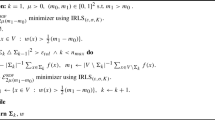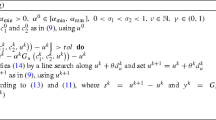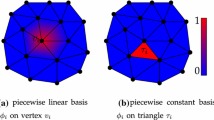Abstract
We propose a numerical approach to solve variational problems on manifolds represented by the grid based particle method (GBPM) recently developed in Leung et al. (J. Comput. Phys. 230(7):2540–2561, 2011), Leung and Zhao (J. Comput. Phys. 228:7706–7728, 2009a, J. Comput. Phys. 228:2993–3024, 2009b, Commun. Comput. Phys. 8:758–796, 2010). In particular, we propose a splitting algorithm for image segmentation on manifolds represented by unconnected sampling particles. To develop a fast minimization algorithm, we propose a new splitting method by generalizing the augmented Lagrangian method. To efficiently implement the resulting method, we incorporate with the local polynomial approximations of the manifold in the GBPM. The resulting method is flexible for segmentation on various manifolds including closed or open or even surfaces which are not orientable.







Similar content being viewed by others
Explore related subjects
Discover the latest articles and news from researchers in related subjects, suggested using machine learning.References
Bae, E., Yuan, J., Tai, X.: Global minimization for continuous multiphase partitioning problems using a dual approach. Int. J. Comput. Vis. 92(1), 112–129 (2011)
Bae, E., Yuan, J., Tai, X.: Simultaneous Convex Optimization of Regions and Region Parameters in Image Segmentation Models, pp. 11–83. Technical Report, UCLA CAM Report (2011)
Bresson, X., Esedoglu, S., Vandergheynst, P., Thiran, J., Osher, S.: Fast global minimization of the active contour/snake model. J. Math. Imaging Vis. 28(2), 151–167 (2007)
Chambolle, A., Pock, T.: A first-order primal-dual algorithm for convex problems with applications to imaging. J. Math. Imaging Vis. 40, 120–145 (2011)
Chan, T., Golub, G., Mulet, P.: A nonlinear primal-dual method for total variation-based image restoration. SIAM J. Sci. Comput. 20(6), 1964–1977 (1999)
Chan, T.F., Vese, L.A.: Active contours without edges. IEEE Trans. Image Process. 10(2), 266–277 (2001). doi:10.1109/83.902291
Cheng, L., Karagozian, A., Chan, T.: The Level Set Method Applied to Geometrically Based Motion, Materials Science, and Image Processing. Ph.D. thesis, University of California, Los Angeles (2000)
Cremers, D., Pock, T., Kolev, K., Chambolle, A.: Convex relaxation techniques for segmentation, stereo and multiview reconstruction. Technical Report, in Advances in Markov Random Fields for Vision and Image Processing, MIT Press (2011)
Delaunoy, A., Fundana, K., Prados, E., Heyden, A.: Convex multi-region segmentation on manifolds. In: 2009 IEEE 12th International Conference on Computer Vision, pp. 662–669 (2009)
Do Carmo, M.P.: Differential Geometry of Curves and Surfaces. Prentice Hall, Englewood Cliffs (1976)
Engquist, B., Tornberg, A., Tsai, R.: Discretization of dirac delta functions in level set methods. J. Comput. Phys. 207, 28–51 (2005)
Goldstein, T., Bresson, X., Osher, S.: Geometric applications of the split bregman method: segmentation and surface reconstruction. J. Sci. Comput. 45, 272–293 (2009)
Goldstein, T., Osher, S.: The split bregman method for l1 regularized problems. SIAM J. Imaging Sci. 2, 323–343 (2009)
Kazufumi, I., Karl, K.: Augmented lagrangian methods for nonsmooth, convex optimization in hilbert spaces. Nonlinear Anal. 41(5–6), 591–616 (2000). doi:10.1016/S0362-546X(98)00299-5
Kimmel, R.: Intrinsic scale space for images on surfaces: the geodesic curvature flow. Gr. Models Image Process. 59(5), 365–372 (1997)
Krueger, M., Delmas, P., GimelFarb, G.: Active contour based segmentation of 3d surfaces. In: In European Conference on Computer Vision, pp. 350–363 (2008)
Lai, R., Liang, J., Zhao, H.: A local mesh method for solving pdes on point clouds, pp. 12–60. Technical Report, UCLA Report (2012)
Leung, S., Lowengrub, J., Zhao, H.: A grid based particle method for solving partial differential equations on evolving surfaces and modeling high order geometrical motion. J. Comput. Phys. 230(7), 2540–2561 (2011). doi:10.1016/j.jcp.010.12.029 http://www.sciencedirect.com/science/article/pii/S0021999110007035
Leung, S., Zhao, H.: A grid based particle method for evolution of open curves and surfaces. J. Comput. Phys. 228, 7706–7728 (2009)
Leung, S., Zhao, H.: A grid based particle method for moving interface problems. J. Comput. Phys. 228, 2993–3024 (2009)
Leung, S., Zhao, H.: Gaussian beam summation for diffraction in inhomogeneous media based on the grid based particle method. Commun. Comput. Phys. 8, 758–796 (2010)
Liang, J., Lai, R., Wong, T., Zhao, H.: Geometric understanding of point clouds using laplace-beltrami operator. IEEE Conference on Computer Vision and Pattern Recognition (2012)
Liang, J., Zhao, H.: Solving partial differential equations on point clouds, pp. 12–25. Technical Report, UCLA Report (2012)
Lie, J., Lysaker, M., Tai, X.C.: A binary level set model and some applications to mumford-shah image segmentation. IEEE Trans. Image Process. 15(5), 1171–1181 (2006)
Liu, J., Ku, Y., Leung, S.: Expectation-maximization algorithm with total variation regularization for vector-valued image segmentation. J. Vis. Commun. Image Represent. 23, 1234–1244 (2012)
Macdonald, C., Ruuth, S.: The implicit closest point method for the numerical solution of partial differential equations on surfaces. SIAM J. Sci. Comput. 31(6), 4330–4350 (2009). doi:10.1137/080740003 http://people.maths.ox.ac.uk/~macdonald/icpm.pdf
Meyer, M., Desbrun, M., Schroder, P., Barr, A.: Discrete differential-geometry operator for triangulated 2-manifolds. In: Hege, H.-C., Polthier, K. (eds.) Visualization and Mathematics III. Springer, Berlin (2002)
Mumford, D., Shah, J.: Optimal approximations by piecewise smooth functions and associated variational problems. Commun. Pure Appl. Math. 42, 577–685 (1989)
Osher, S., Sethian, J.: Fronts propagating with curvature dependent speed: algorithms based on hamiltonjacobi formulations. J. Comput. Phys. 79, 12–49 (1988)
Peskin, C.: Numerical analysis of blood flow in the heart. J. Comput. Phys. 25, 220–252 (1977)
Rockafellar, R.: A dual approach to solving nonlinear programming problems by unconstrained optimization. Math. Program. 5, 354–373 (1973)
Setzer, S.: Operator splittings, bregman methods and frame shrinkage in image processing. Int. J. Comput. Vis. 92(3), 265–280 (2010)
Smereka, P.: Spiral crystal growth. Phys. D 128, 282–301 (2000)
Tian, L., Macdonald, C., Ruuth, S.: Segmentation on surfaces with the closest point method. In: Proc. ICIP09, 16th IEEE International Conference on Image Processing, pp. 3009–3012. Cairo (2009). doi:10.1109/ICIP.2009.5414447 http://people.maths.ox.ac.uk/~macdonald/TianMacdonaldRuuth.pdf
Tornberg, A., Engquist, B.: Numerical approximations of singular source terms in differential equations. J. Comput. Phys. 200, 462–488 (2004)
Wan, M., Wang, Y., Bae, E., Tai, X., Wang, D.: Reconstructing open surfaces via graph-cuts. IEEE Trans. Vis. Comput. Gr. (2012). doi:10.1109/TVCG.2012.119
Wang, Y., Yang, J., Yin, W., Zhang, Y.: A new alternating minimization algorithm for total variation image reconstruction. SIAM J. Imaging Sci. 1(3), 248–272 (2008)
Wu, C., Tai, X.: Augmented lagrangian method, dual methods, and split bregman iteration for rof, vectorial tv, and high order models. SIAM J. Imaging Sci. 3(3), 300–339 (2010)
Wu, C., Tai, X.: A level set formulation of geodesic curvature flow on simplicial surfaces. IEEE Trans. Vis. Comput. Gr. 16(4), 647–662 (2010)
Wu, C., Zhang, J., Duan, Y., Tai, X.: Augmented lagrangian method for total variation based image restoration and segmentation over triangulated surfaces. J. Sci. Comput. 50(1), 145–166 (2012)
Acknowledgments
Leung would like to thank Prof. Ronald LM Lui for providing a conformal map of the Stanford bunny data to a sphere. The work of Leung was supported in part by the Hong Kong RGC under Grant GRF602210 and the HKUST grant RPC11SC06. The work of Liu was supported by National Natural Science Foundation of China (No. 11201032).
Author information
Authors and Affiliations
Corresponding author
Appendices
Appendix 1. Proof of Theorem 1
We first prove the following lemma
Lemma 1
Suppose \(\mathcal J _1(\mathbf{v })\) is continuous and convex on a Hilbert space \(\mathbb V \), and
where \(\eta >0\) and \(\mathbf{g }\) is a positive definite and linear symmetric operator with bounded inverse, then the sequence \(\{\mathbf{v }^n\}\) produced by the iteration scheme
converges, i.e. \(\mathbf{v }^n\rightarrow \mathbf{v }^{*}\) when \(0<\tau <\frac{2\eta }{\Lambda _{\max }}\), where \(\mathbf{v }^{*}\) is the saddle point \((\mathbf{v }^*,\mathbf{p }^*)\) of \(\mathcal J (\mathbf{v },\mathbf{p })\). Here \(\Lambda _{\max }\) is the largest eigenvalue of \(\mathbf{g }\).
Proof
Since \((\mathbf{v }^*,\mathbf{p }^*)\) is a saddle of \(\mathcal J \), we have \(\mathbf{v }^*=\mathbf{b }\) by \(\frac{\partial \mathcal J }{\partial \mathbf{p }}|_{(\mathbf{p }^*,\mathbf{v }^*)}=0\). Let \(\partial \mathcal J _1(\mathbf{v })\) be the subgradient of \(\mathcal J _1\) at \(\mathbf{v }\), i.e. \(\partial \mathcal J _1(\mathbf{v })=\{\bar{\mathbf{v }}\in \bar{\mathbb{V }}:\mathcal J _1(\mathbf q )-\mathcal J _1(\mathbf v )\geqslant <\bar{\mathbf{v }},\mathbf q -\mathbf v >, \forall \mathbf q \in \mathbb V \}\), where \(\bar{\mathbb{V }}\) is the conjugate space of \(\mathbb V \). According to the first order optimization conditions of (19), we have
thus
Taking the inner product with \(\mathbf v ^{n+1}-\mathbf v ^*\) for both sides of the above equation, it becomes
By the iteration Eq. (20) and the fact that \(\mathbf v ^*-\mathbf b =0\), we have
Taking the norm for the both sides of the above equation, we get
Substituting (21) into (22), we have
Since \(\mathcal J _1\) is convex, \(\mathbf d ^{n+1}\in \partial \mathcal J _1(\mathbf v ^{n+1})\) and \(\mathbf d ^{*}\in \partial \mathcal J _1(\mathbf v ^{*})\), thus
With the condition \(0<\tau <\frac{2\eta }{\Lambda _{\max }}\), we conclude that the operator \(-\tau ^2\mathbf g ^2+2\tau \eta \mathbf g \) is positive definite.
Now, using both (23) and (24), we have \(||\mathbf p ^{n+1}-\mathbf p ^{*}||^2 -||\mathbf p ^{n}-\mathbf p ^{*}||^2<0\), which implies that the sequence \(||\mathbf p ^{n}-\mathbf p ^{*}||^2\) is monotonic decreasing with a lower bound \(0\) and so it must be convergent.
Finally from (23), we conclude that \(\mathbf v ^{n}\rightarrow \mathbf v ^{*}\). \(\square \)
Now, we can use this Lemma to prove Theorem 1. It is easy to check that \(\lambda \int _{\mathcal{M }}\sqrt{\mathbf{v}^\mathrm{T }\mathbf{gv}} \,\mathrm d M\) is convex when \(\mathbf g \) is positive definite. For any fixed \(u\) and \(\mathbf c \), let \(\mathbf b =\nabla _s u\) and follow the lemma, one can show that \(\{\mathbf{v}^n\}\) produced by Eqs. (8) and (10) converges to the saddle point \((\cdot ,\mathbf v ^*,\mathbf{p}^*,\cdot )\) of \(L(\cdot ,\mathbf v ,\mathbf p ,\cdot )\), i.e. \(\mathbf v ^n\rightarrow \mathbf v ^*\). Since \((\cdot ,\mathbf v ^*,\mathbf p ^*,\cdot )\) is the saddle point, we have \(\mathbf v ^{*}=\nabla _s u\), which completes the proof.
Appendix 2. Derivation of (11)
The directional derivative
By the variational formulation \(\displaystyle \biggl .\frac{\mathrm{d }\tilde{L}(u+\tau w)}{\mathrm{d } \tau }|_{\tau =0}=<\frac{\delta \tilde{L}}{\delta u},w>\), one gets
which leads to Eq. (11).
Appendix 3. Derivation of (12)
Denote \(\mathbf{q }^n=\nabla _\mathbf{s }u^{n+1}-\frac{\mathbf{p }^n}{\eta }\), we have
Solving \(\frac{\delta \tilde{L}}{\delta \mathbf{v }}=0\) for \(\mathbf{v }\), we get
Taking modulus \(||\cdot ||_\mathbf{g }\) for the two sides of (25), it becomes
if \(||\mathbf q ^{n}||_\mathbf{g }\geqslant \frac{\lambda }{\eta }\). Plugging it back to the above (25), we get
On the other hand, if \(||\mathbf q ^n||_\mathbf{g }<\frac{\lambda }{\eta }\), then
This means that \(\mathbf v ^{n+1}=0\) must be the minimizer of \(\tilde{L}\) with respect to \(\mathbf v \). Summarizing these two results, we get the \(\mathbf g \)-shrinkage operator (12).
Appendix 4. Minimizer of (14)
Let \(\mathbf H =\sum _{j=1}^m \left(\mathbf x ^j-\mathbf x ^i\right)\left(\mathbf x ^j-\mathbf x ^i\right)^\mathrm{T }=\mathbf U \begin{pmatrix} \lambda _1&\,&\\&\lambda _2&\\&\,&\lambda _3\\ \end{pmatrix} \mathbf U ^\mathrm{T } \), where \(\lambda _1\geqslant \lambda _2\geqslant \lambda _3\) and \(\mathbf U =\begin{pmatrix} U_1&U_2&U_3 \\ \end{pmatrix}\) is an orthogonal matrix. Then
Since \(\left(\mathbf U ^\mathrm{T }\tilde{\mathbf{n }}\right)^\mathrm{T } \left(\mathbf U ^\mathrm{T }\tilde{\mathbf{n }}\right)=1\), thus we have \(E\geqslant \lambda _3\). If \(\tilde{\mathbf{n }}=U_3\), \(E=U_3^\mathrm T \mathbf H U_3=\lambda _3\). Thus we conclude that \(\mathbf n =U_3\) is a minimizer of \(E\) such that \(|\mathbf n |=1\), which completes the proof.
Appendix 5. Explicit formula for the gradient descent update \(\Delta u^i\)
In this Appendix, we state explicitly the formula to compute the gradient descent update of \(u^i\) as a function of the coefficients of the second order polynomial approximation in the GBPM representation. For convenience, let us denote \(h_j=v_j^n+\frac{1}{\eta }p_j^n\) and write the coefficients of the approximated second-degree polynomial at \(\varvec{x}^i\) for functions \(h_1\) and \(h_2\) as \(\gamma _{\tau _1\tau _2}^i, \delta _{\tau _1\tau _2}^i (0\leqslant \tau _1+\tau _2\leqslant 2,\tau _1,\tau _2\in \mathbb N )\), respectively.
The PDE (11) in the explicit form is given by
where
and
Now, replacing all local geometry by the local polynomial least square approximation, we have
where
and
Rights and permissions
About this article
Cite this article
Liu, J., Leung, S. A Splitting Algorithm for Image Segmentation on Manifolds Represented by the Grid Based Particle Method. J Sci Comput 56, 243–266 (2013). https://doi.org/10.1007/s10915-012-9675-7
Received:
Revised:
Accepted:
Published:
Issue Date:
DOI: https://doi.org/10.1007/s10915-012-9675-7
Keywords
Profiles
- Shingyu Leung View author profile




